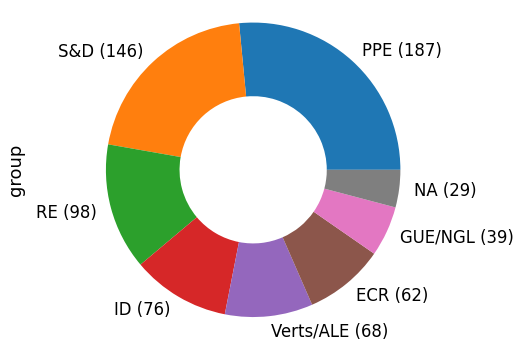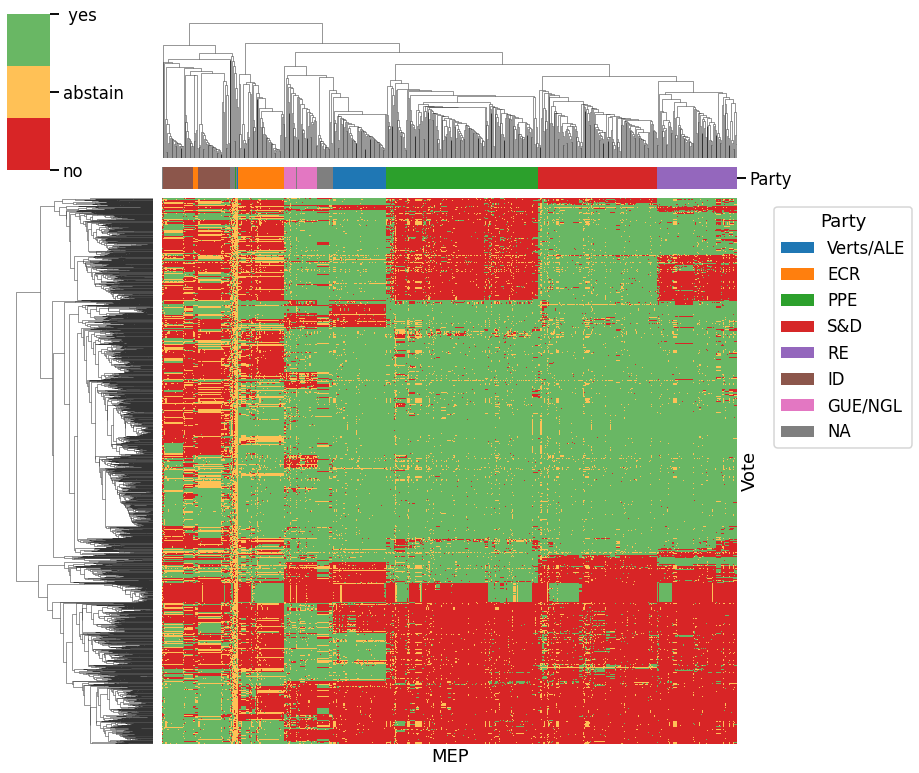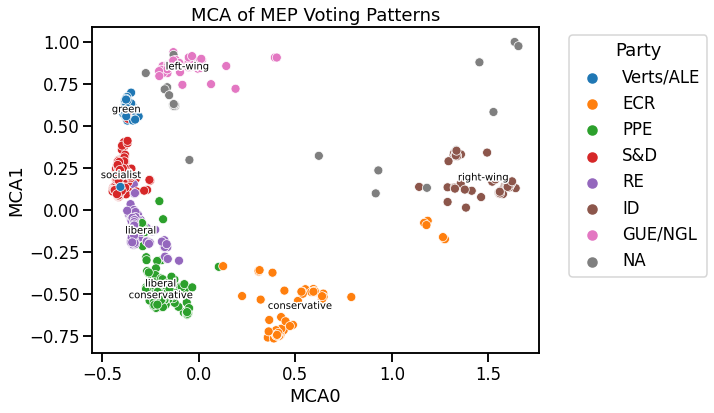Analyzing the European Parliament
[1]:
import json
import numpy as np
import pandas as pd
import seaborn as sns
import matplotlib.pyplot as plt
from matplotlib.patches import Patch
import matplotlib.patheffects as PathEffects
from matplotlib.ticker import FuncFormatter, FixedLocator
import bokeh.models as bmo
import bokeh.plotting as bpl
from bokeh.palettes import d3
import prince
import palettable
from tqdm.auto import tqdm
[2]:
sns.set_context('talk')
bpl.output_notebook()
Download data
All data is readily available on Parltrack.
[3]:
# %%bash
# wget --no-clobber https://parltrack.org/dumps/ep_votes.json.lz
# lzip -d ep_votes.json.lz
# wget --no-clobber https://parltrack.org/dumps/ep_meps.json.lz
# lzip -d ep_meps.json.lz
Transform JSON to dataframes
To easily work with the data, we transform it from JSON to pandas dataframes.
MEPs
[4]:
fname = 'ep_meps.json'
tmp = []
with open(fname) as fd:
for line in tqdm(fd.readlines()):
line = line.lstrip('[,]')
if len(line) == 0:
continue
data = json.loads(line)
# if not data['active']:
# continue
tmp.append(
{
'UserID': data['UserID'],
'name': data['Name']['full'],
'birthday': data['Birth']['date'] if 'Birth' in data else np.nan,
'active': data['active'],
'group': data.get('Groups', [{'groupid': np.nan}])[-1][
'groupid'
], # assumption: last group is latest one. Is this true?
}
)
[5]:
df_meps = pd.DataFrame(tmp)
df_meps['birthday'] = pd.to_datetime(df_meps['birthday'])
df_meps.set_index('UserID', inplace=True)
df_meps['group'].replace(
{'Group of the European United Left - Nordic Green Left': 'GUE/NGL'}, inplace=True
) # is there a difference?
df_meps.head()
[5]:
| name | birthday | active | group | |
|---|---|---|---|---|
| UserID | ||||
| 2307 | Hubert PIRKER | 1948-10-03 | False | PPE |
| 111496 | María Auxiliadora CORREA ZAMORA | 1972-05-24 | False | PPE |
| 110987 | Gino TREMATERRA | 1940-09-03 | False | PPE |
| 1965 | Jan MULDER | 1943-10-03 | False | ALDE |
| 39321 | Vicente Miguel GARCÉS RAMÓN | 1946-11-10 | False | S&D |
Votes
[6]:
fname = 'ep_votes.json'
tmp = []
tmp_matrix = {}
with open(fname) as fd:
for line in tqdm(fd.readlines()):
line = line.lstrip('[,]')
if len(line) == 0:
continue
data = json.loads(line)
tmp.append(
{'date': data['ts'], 'voteid': data['voteid'], 'title': data['title']}
)
if 'votes' in data:
tmp_matrix[data['voteid']] = {
**{
mep['mepid']: '+'
for mep_list in data['votes']
.get('+', {'groups': {'foo': []}})['groups']
.values()
for mep in mep_list
if 'mepid' in mep
},
**{
mep['mepid']: '-'
for mep_list in data['votes']
.get('-', {'groups': {'foo': []}})['groups']
.values()
for mep in mep_list
if 'mepid' in mep
},
**{
mep['mepid']: '0'
for mep_list in data['votes']
.get('0', {'groups': {'foo': []}})['groups']
.values()
for mep in mep_list
if 'mepid' in mep
},
}
[7]:
df_votematrix = pd.DataFrame.from_dict(tmp_matrix, orient='index')
df_votematrix.index.name = 'voteid'
df_votematrix.columns.name = 'mepid'
# df_votematrix.sort_values('voteid', axis=0, inplace=True)
df_votematrix.sort_values('mepid', axis=1, inplace=True)
df_votematrix.head()
[7]:
| mepid | 1 | 234 | 684 | 729 | 840 | 945 | 966 | 988 | 997 | 1002 | ... | 204416 | 204418 | 204419 | 204420 | 204421 | 204443 | 204449 | 204733 | 205452 | 206158 |
|---|---|---|---|---|---|---|---|---|---|---|---|---|---|---|---|---|---|---|---|---|---|
| voteid | |||||||||||||||||||||
| 7754 | NaN | NaN | + | + | NaN | NaN | NaN | NaN | NaN | NaN | ... | NaN | NaN | NaN | NaN | NaN | NaN | NaN | NaN | NaN | NaN |
| 7818 | - | + | - | - | NaN | - | NaN | NaN | + | - | ... | NaN | NaN | NaN | NaN | NaN | NaN | NaN | NaN | NaN | NaN |
| 7759 | + | + | + | + | NaN | + | + | NaN | + | NaN | ... | NaN | NaN | NaN | NaN | NaN | NaN | NaN | NaN | NaN | NaN |
| 7755 | NaN | 0 | + | NaN | NaN | + | 0 | NaN | + | + | ... | NaN | NaN | NaN | NaN | NaN | NaN | NaN | NaN | NaN | NaN |
| 7760 | - | - | - | - | NaN | - | + | NaN | + | - | ... | NaN | NaN | NaN | NaN | NaN | NaN | NaN | NaN | NaN | NaN |
5 rows × 2329 columns
[8]:
df_votes = pd.DataFrame(tmp)
df_votes['date'] = pd.to_datetime(df_votes['date'])
df_votes.set_index('voteid', inplace=True)
df_votes.tail()
[8]:
| date | title | |
|---|---|---|
| voteid | ||
| 116359 | 2020-07-23 12:49:32 | B9-0229/2020 - Am 23 |
| 116398 | 2020-07-23 12:49:32 | B9-0229/2020 - § 26/1 |
| 116399 | 2020-07-23 12:49:32 | B9-0229/2020 - § 26/2 |
| 116360 | 2020-07-23 12:49:32 | B9-0229/2020 - Am 1 |
| 116401 | 2020-07-23 16:52:06 | B9-0229/2020 - Résolution |
Exploration
We can then look at a few simple statistics.
MEP party distribution
How many members (MEPs) does each party of the European parliament have?
[9]:
df_meps['active'].sum()
[9]:
705
[10]:
group_counts = df_meps.loc[df_meps['active'], 'group'].value_counts()
labels = group_counts.to_frame().apply(lambda x: f'{x.name} ({x.iloc[0]})', axis=1)
ax = group_counts.plot.pie(figsize=(8, 6), labels=labels, wedgeprops=dict(width=0.5))
ax.axis('equal')
[10]:
(-1.1107175100739686,
1.1005103586792213,
-1.1057638158926402,
1.1094386022707399)

MEP age distribution
And how old are these members?
[11]:
df_meps['age'] = (pd.Timestamp.today() - df_meps['birthday']) / np.timedelta64(1, 'Y')
[12]:
g = sns.displot(
data=df_meps[df_meps['active']],
x='age',
col='group',
col_wrap=3,
height=3,
aspect=4 / 3,
)
g.set_xlabels('MEP age [years]')
[12]:
<seaborn.axisgrid.FacetGrid at 0x1635ff130>

Voting patterns
Let’s now take a look at how these MEPs vote.
[13]:
df_votematrix.head()
[13]:
| mepid | 1 | 234 | 684 | 729 | 840 | 945 | 966 | 988 | 997 | 1002 | ... | 204416 | 204418 | 204419 | 204420 | 204421 | 204443 | 204449 | 204733 | 205452 | 206158 |
|---|---|---|---|---|---|---|---|---|---|---|---|---|---|---|---|---|---|---|---|---|---|
| voteid | |||||||||||||||||||||
| 7754 | NaN | NaN | + | + | NaN | NaN | NaN | NaN | NaN | NaN | ... | NaN | NaN | NaN | NaN | NaN | NaN | NaN | NaN | NaN | NaN |
| 7818 | - | + | - | - | NaN | - | NaN | NaN | + | - | ... | NaN | NaN | NaN | NaN | NaN | NaN | NaN | NaN | NaN | NaN |
| 7759 | + | + | + | + | NaN | + | + | NaN | + | NaN | ... | NaN | NaN | NaN | NaN | NaN | NaN | NaN | NaN | NaN | NaN |
| 7755 | NaN | 0 | + | NaN | NaN | + | 0 | NaN | + | + | ... | NaN | NaN | NaN | NaN | NaN | NaN | NaN | NaN | NaN | NaN |
| 7760 | - | - | - | - | NaN | - | + | NaN | + | - | ... | NaN | NaN | NaN | NaN | NaN | NaN | NaN | NaN | NaN | NaN |
5 rows × 2329 columns
Who is the most active MEP?
Here we equate “active” with “has voted most often”. This is most likely quite misleading.
[14]:
df_hasvoted = ~df_votematrix[df_meps[df_meps['active']].index].isna()
[15]:
df_hasvoted.sum(axis=0).sort_values(ascending=False).to_frame('vote_count').merge(
df_meps, how='left', left_index=True, right_index=True
).head(10)
[15]:
| vote_count | name | birthday | active | group | age | |
|---|---|---|---|---|---|---|
| mepid | ||||||
| 28266 | 22954 | Sophia in 't VELD | 1963-09-13 | True | RE | 57.711345 |
| 1913 | 22703 | Evelyne GEBHARDT | 1954-01-19 | True | S&D | 67.359729 |
| 2323 | 22394 | Rainer WIELAND | 1957-02-19 | True | PPE | 64.274108 |
| 4246 | 22324 | Othmar KARAS | 1957-12-24 | True | PPE | 63.430833 |
| 28219 | 22324 | Daniel CASPARY | 1976-04-04 | True | PPE | 45.152566 |
| 2341 | 22269 | Michael GAHLER | 1960-04-22 | True | PPE | 61.103612 |
| 28224 | 22164 | Markus PIEPER | 1963-05-15 | True | PPE | 58.042632 |
| 28298 | 21992 | Iratxe GARCÍA PÉREZ | 1974-10-07 | True | S&D | 46.644725 |
| 23821 | 21912 | József SZÁJER | 1961-09-07 | True | PPE | 59.726445 |
| 28223 | 21910 | Andreas SCHWAB | 1973-04-09 | True | PPE | 48.139622 |
Select subset of data
For the subsequent vote clustering, we restrict ourselves to recent votes of active MEPs starting with 2020 (and remove MEPs with no votes at all).
[16]:
df_subset = df_votematrix.loc[
df_votematrix.index.intersection(df_votes[df_votes['date'] > '2020'].index),
df_meps[df_meps['active']].index,
].dropna(how='all', axis=1)
print(df_subset.shape)
df_subset.head()
(1808, 703)
[16]:
| UserID | 96750 | 4746 | 23788 | 96810 | 96808 | 4560 | 38595 | 1992 | 125106 | 4391 | ... | 204413 | 204334 | 204331 | 204346 | 204449 | 204400 | 197780 | 204733 | 205452 | 206158 |
|---|---|---|---|---|---|---|---|---|---|---|---|---|---|---|---|---|---|---|---|---|---|
| voteid | |||||||||||||||||||||
| 111241 | 0 | NaN | NaN | NaN | + | NaN | NaN | NaN | + | NaN | ... | NaN | NaN | NaN | NaN | NaN | NaN | NaN | NaN | NaN | NaN |
| 111141 | + | NaN | NaN | + | + | + | NaN | NaN | + | NaN | ... | NaN | NaN | NaN | NaN | NaN | NaN | NaN | NaN | NaN | NaN |
| 111142 | + | NaN | NaN | + | + | + | NaN | + | + | NaN | ... | NaN | NaN | NaN | NaN | NaN | NaN | NaN | NaN | NaN | NaN |
| 111143 | + | NaN | NaN | + | + | + | NaN | + | + | NaN | ... | NaN | NaN | NaN | NaN | NaN | NaN | NaN | NaN | NaN | NaN |
| 111781 | - | NaN | NaN | + | - | - | NaN | - | + | NaN | ... | NaN | NaN | NaN | NaN | NaN | NaN | NaN | NaN | NaN | NaN |
5 rows × 703 columns
Clustered data overview
Here, we cluster both MEPs and votes as well as highlight each MEP column with their respective party association.
[17]:
# process data to work with clustermap
tmp = df_subset.fillna(0).replace({'+': 1, '0': 0, '-': -1}) # .iloc[:10, :10]
tmp.columns.rename('MEP', inplace=True)
tmp.index.rename('Vote', inplace=True)
# infer party colors
party_colors = {
party: sns.color_palette('tab10')[i]
for i, party in enumerate(df_meps.loc[tmp.columns, 'group'].unique())
}
party_cmap = (
tmp.T.merge(df_meps['group'], how='inner', left_index=True, right_index=True)[
'group'
]
.map(party_colors)
.rename('Party')
)
# main plot
g = sns.clustermap(
tmp,
col_colors=party_cmap,
cmap=palettable.tableau.TrafficLight_9.hex_colors[3:6],
figsize=(12, 12),
)
# plot improvements
g.ax_heatmap.tick_params(bottom=False, labelbottom=False, right=False, labelright=False)
@FuncFormatter
def formatter(x, pos):
return {-1: 'no', 0: 'abstain', 1: ' yes'}[x]
g.cax.yaxis.set_major_locator(FixedLocator([-1, 0, 1]))
g.cax.yaxis.set_major_formatter(formatter)
# party color legend
g.ax_heatmap.legend(
handles=[
Patch(facecolor=color, label=name) for name, color in party_colors.items()
],
title='Party',
bbox_to_anchor=(1.05, 1),
loc='upper left',
)
# TODO: improve overall colorbar/legend placement
[17]:
<matplotlib.legend.Legend at 0x155e363a0>

Project MEPs based on vote patterns
We will now visualize the landscape of MEPs in two dimensions based on the voting patterns using Multiple Correspondence Analysis.
Apply Multiple Correspondence Analysis (MCA)
[18]:
mca = prince.MCA(n_components=2)
df_mca = mca.fit_transform(df_subset.T)
df_mca.columns = ('MCA0', 'MCA1')
df_mca.index.rename('mepid', inplace=True)
df_mca['group'] = df_meps.loc[df_meps['active'], 'group']
print(df_mca.shape)
df_mca.head()
(703, 3)
[18]:
| MCA0 | MCA1 | group | |
|---|---|---|---|
| mepid | |||
| 96750 | -0.371809 | 0.631197 | Verts/ALE |
| 4746 | 0.593274 | -0.471376 | ECR |
| 23788 | 0.398250 | -0.753624 | ECR |
| 96810 | 0.604044 | -0.488594 | ECR |
| 96808 | -0.231881 | -0.476251 | PPE |
Static visualization
[19]:
# obtained from the information box on each party's Wikipedia entry
party_ideology = {
'Verts/ALE': 'green',
'ECR': 'conservative',
'PPE': 'liberal\nconservative',
'S&D': 'socialist',
'RE': 'liberal',
'ID': 'right-wing',
'GUE/NGL': 'left-wing',
}
[20]:
fig, ax = plt.subplots(figsize=(8, 6))
sns.scatterplot(data=df_mca, x='MCA0', y='MCA1', hue='group', ax=ax)
for party, row in df_mca.groupby('group').mean().iterrows():
if party == 'NA':
continue
ax.text(
row.MCA0,
row.MCA1,
party_ideology.get(party),
ha='center',
va='center',
fontsize=10,
path_effects=[PathEffects.withStroke(linewidth=3, foreground="w")],
)
ax.legend(loc='upper left', bbox_to_anchor=(1.05, 1), ncol=1, title='Party')
ax.set_title('MCA of MEP Voting Patterns')
[20]:
Text(0.5, 1.0, 'MCA of MEP Voting Patterns')

Interactive visualization
You can zoom and pan the visualization. Hovering over each point (corresponding to a MEP) will display relevant information.
[21]:
# generate data for each tooltip
hover_data = df_meps.loc[df_mca.index]
hover_data['name'] = hover_data['name'].str.title()
hover_data['birthday'] = hover_data['birthday'].apply(
lambda x: x.strftime("%Y-%m-%d") if not pd.isnull(x) else 'undef'
)
hover_data['age'] = hover_data['age'].apply(
lambda x: int(x) if not pd.isnull(x) else -1
)
df_data = df_mca.merge(
hover_data.drop('group', axis=1), left_index=True, right_index=True
)
df_data.head()
[21]:
| MCA0 | MCA1 | group | name | birthday | active | age | |
|---|---|---|---|---|---|---|---|
| mepid | |||||||
| 96750 | -0.371809 | 0.631197 | Verts/ALE | François Alfonsi | 1953-09-14 | True | 67 |
| 4746 | 0.593274 | -0.471376 | ECR | Sergio Berlato | 1959-07-27 | True | 61 |
| 23788 | 0.398250 | -0.753624 | ECR | Adam Bielan | 1974-09-12 | True | 46 |
| 96810 | 0.604044 | -0.488594 | ECR | Carlo Fidanza | 1976-09-21 | True | 44 |
| 96808 | -0.231881 | -0.476251 | PPE | Pablo Arias Echeverría | 1970-06-30 | True | 50 |
[22]:
# set up point colors
palette = d3['Category10'][df_data['group'].nunique()]
color_map = bmo.CategoricalColorMapper(
factors=df_data['group'].unique(), palette=palette
)
[23]:
# create figure
p = bpl.figure(
tools='hover,pan,reset,wheel_zoom,box_zoom',
active_scroll='wheel_zoom',
tooltips=[(col, f'@{col}') for col in hover_data],
background_fill_color='black',
)
p.scatter(
x='MCA0',
y='MCA1',
color={'field': 'group', 'transform': color_map},
legend_field='group',
size=5,
source=df_data,
)
p.grid.visible = False
p.axis.visible = False
bpl.show(p)